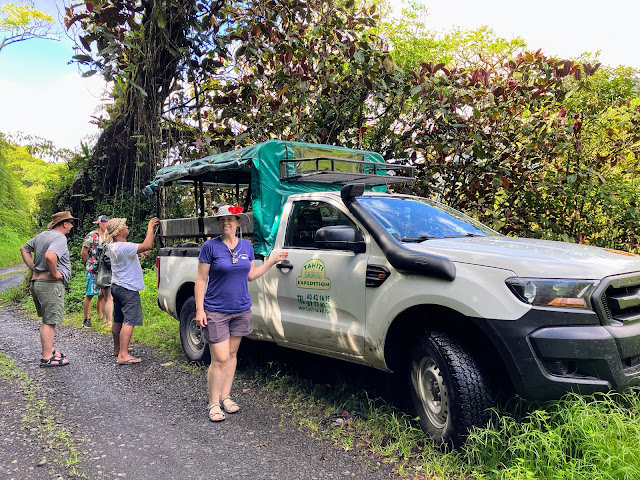"Ia Orana" means "Hello" in Tahitian. It all runs together when you say it out loud: "Yo-ranna". If you say it in a sing-songy voice you will sound just like the locals do!
All US flights in and out of French Polynesia land in the capitol of Pape'ete, Tahiti, so we booked a few nights at an Airbnb and rented a car so we could see the main island. Our first day with the car we drove the north coast, stopping at several viewpoints including Faarumai Waterfalls.
The water on the north stretch of the coast is deeper and lacks the shallow reefs and calm lagoon waters that give pictures that famous turquoise blue hue. So the coastline here looked a little more rugged than we expected. We could also see the remains of lava flows in the black volcanic rocks along the shoreline.
The main road in Tahiti snakes around the coast of the island. There is only one road that crosses the interior of the island - through the Papeno'o Valley. The road isn't maintained, so you can't drive it in a rental car. Instead you have to book a Jeep or 4x4 tour.
The interior of the island gets tons of rain (Tahiti gets 75 inches annually). It's lush and green and there are waterfalls everywhere you look. We enjoyed seeing the Papeno'o Valley, but it was a long day -- about 8 hours for the whole tour. By the time we got back we were hungry and exhausted.
Luckily the safari tour dropped us off at the town hall in the village of Puna'auia. Just across the street is a public beach where several food trucks serve tasty dinners in the evenings. The food trucks are called "roulottes" and you can find them throughout the islands. They are a little different from our American concept of food trucks that move around -- typically the roulottes have permanent locations and many of them have substantial menus and designated seating areas. Compared to sit-down restaurants, the food at a roulotte is generally less expensive, and we found ourselves eating at them several times during our stay in French Polynesia.
French Polynesia is spread out over a large area in the Pacific and is broken up into five island groups. The island group we are visiting on this trip is called the "Society Islands" and includes Tahiti, Mo'orea, Raiatea, and Bora Bora as well as many smaller islands and atolls. Tahiti is the largest island in the Society Island chain. From the air, it looks like two round blobs of land attached to each other by a narrow neck. The bigger one is to the northwest and is called "Tahiti Nui" (big Tahiti); the smaller one to the southeast is called "Tahiti Iti" (little Tahiti). On the west coast, you can drive down as far as Teahupo'o, where the road ends. This little town is known for the world-class surf break just offshore. This will be the site for the surfing competition of the 2024 Summer Olympics -- almost halfway around the world from the main event in the city of Paris.
We turned around at Teahupo'o and drove back up the Tahiti Iti coast to a seaside restaurant called La Plage de Maui. We had an excellent meal there. Kevin was adventurous and ordered the gourmet plate which consisted of both raw and cooked fish. While Hawaii is known for poke (raw fish marinated in a salty, non-citrus-based sauce), the signature dish in these islands is called "poisson cru". The French name literally translates to "raw fish", and it is made with raw fish tossed in citrus juice and then marinated in coconut milk. In the photo below it's in the round dish next to the rice. And yes - that is a raw shrimp in the lower left corner of the plate. I consider myself a reasonably adventurous eater but I draw the line at raw shellfish. Kevin ate it and lived to tell the tale!
On our way back up the coast we found a nice spot at Vaiava Beach and went snorkeling. Visibility wasn't great, but it was nice to get in the water. We are hoping to see some better snorkeling spots on the island of Mo'orea -- our next stop!









No comments:
Post a Comment